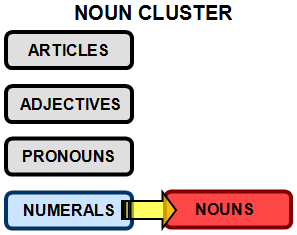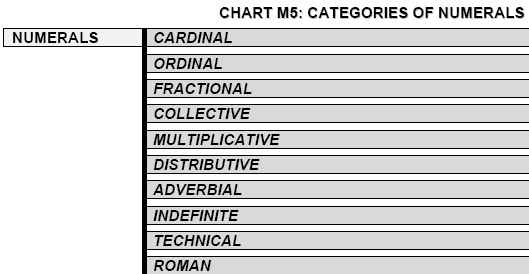
Attachments_setltd@mail.ru_2012-06-24_15-33-11 английский язык / 19 numeral
.docx19 We know that words on the upper level of classification are divided into notional and functional.
To the notional parts of speech of the English language belong the noun, the adjective, the numeral, the pronoun, the verb, the adverb.
The features of the numeral: 1) the categorial meaning of number (cardinal and ordinal); 2) the narrow set of simple numerals; the specific forms of composition for compound numerals; the specific suffixal forms of derivation for ordinal numerals; 3) the functions of numerical attribute and numerical substantive.
"Numeral" is
the sentence element used to express an abstract numerical value, to
identify elements from orderly sequential structures, and to specify
the noun.
Most
English grammar books do not consider that numerals form a distinct
category of morphologic elements. What they do is, they label
numerals as "adjectives", "adverbs", or (the
easiest one) they do not present numerals at all.
2 спикер
In fact, most of the confusion existing today in English grammar comes exactly from the fact that many authors of grammar books do not understand the nature of numerals--believe it or not. Note that using complex numerals is a direct indicator of an advanced civilization; in addition, numerals are one of the few primordial factors that have generated any language (anywhere in the Universe).
With numerals, even more than with pronouns, it is difficult to keep the strictly grammatical approach
There are no grammatical categories to be discussed in numerals. There is no category of number, nor of case, nor any other morphological category. The numerals are, to all intents and purposes, invariable. So there is only the function of numerals to be considered, and also possibilities of their substantivisation.
The most characteristic function of numerals is of course that of an attribute preceding its noun. However a numeral can also perform other functions in the sentence (it can be subject, predicative, and object) if the context makes it clear what objects are meant, as in: We are seven, Of the seven people 1 was looking for I found only three.
The numerals, both cardinal and ordinal, share certain peculiarities of syntactic construction with pronouns. Cf., e. g., five children, five of the children, five of them; some children, some of the children, some of them; also the first travellers, the first of the travellers, the first of them. This, however, does not seem a sufficient reason for uniting pronouns and numerals into one part of speech.
3 и 4 спикеры по очереди (Катя, Даша К.)
Kinds of the numerals are presented in this page according to the following simplified structure:

-
Cardinal numerals express integer (whole) abstract numbers in mathematical symbols and in word form. Cardinal numerals work, morphologically, as nouns, adjectives, adverbs, and pronouns. Example: one, twenty-two, 150 etc.
-
Ordinal numeral specifies the place of one element in an orderly series/structure. Example: the first, the twenty-second
-
Fractional numeral is used to express whole numbers (integers) plus their decimal/fractional part. Fractional numerals take two forms: A. common fraction – 1:3 B. decimal numbers (десятичные дроби)- 1.6
-
Collective: A numeral, which signifies that several persons or things are taken definitely and unitedly together, in the sense of — both, all three, all four, etc.
-
Multiplicative: A few numbers have specialised multiplicative numerals expresses how many fold or how many times[3]:
one time
once
two times
twice
three times
thrice
-
Distributive: do not exist in English (numerals formed by duplication, affixation)
-
Adverbal: once, twice, for the first time (function as adverbs)
-
The variety of technical numerals is great. Example: micro, milli, giga
-
Roman numerals: the numeric system of ancient Rome, uses combinations of letters from the Latin alphabet to signify values
1.Difficulties in spelling four BUT forty, fortieth five BUT fifteen, fifty, fifth eight BUT eighth nine BUT ninth twelve BUT twelfth thirty BUT thirtieth There is a hyphen between tens and digits, e.g. twenty-two, one hundred and eighty-seven
2. Fractions: ½ - a half 2 ½ - two and a half ¼ - a quarter ¾ - three quarters (three fourth) ⅛ - one eighth (an eighth) ⅞ - seven eighths
-
спикер (Лена)
3.General remarks about cardinal numbers a) 1,000,000,000 is a thousand million in British English, and a billion in American English. The American way of reading the number 1,000,000,000 is getting more and more common. b) A comma is used instead of spaces or dots to separate the thousands. Spaces are possible in British English only. c) The words ‘hundred’, ‘thousand’, ‘million’, ‘dozen’ are not pluralized when they are given with a specific number or with such expressions as ‘a few’, ‘several’, ‘many’. They are pluralized if there is no number of them given (e.g. thousands of people). d) In British English we say ‘and’ after the word ‘hundred’, e.g. 113 - one hundred and thirteen; 320,000 - three hundred and twenty thousand e) ‘A’ before ‘hundred’, ‘thousand’, ‘million’ etc. is more popular than ‘one’ if these numbers stand alone, e.g. 100 - a hundred Otherwise ’one” is more popular, e.g. 1,140 - one thousand one hundred and forty f) In bigger numbers, we put ‘and’ before the tens when the hundreds are missing, e.g. we have the year two thousand and five. g) Round numbers between 1,100 and 1,900 are often read ‘fifteen hundred’, ‘eighteen hundred’ etc. h) 12 is a dozen; 20 is a score; 60 is threescore; 144 is a gross i) anything above 1 is already plural in English, e.g. 1.5 litres of water j) centuries are given in Arabic numbers, e.g. we live in 21st century. 4. Decimals: NB: in English a ‘point’, not a comma, is used in decimal fractions! We read the digits after the point separately. 0.5 - oh (OR: nought) point five 2.5 - two point five 0.75 - oh point seven five 15.735 - fifteen point seven three five
6 спикер
5. Ways of saying the number 0: - generally, the figure ‘0’ is usually called ‘nought’ in BrE, and ‘zero’ in AmE. - in a series of numbers (such as a credit card number or telephone number) you can pronounce 0 like the letter o; - in mathematics, science, and technical contexts say nought or zero (sometimes also ‘cipher’); - in temperatures say zero to refer to freezing point (0 Celsius or -32 Fahrenheit); - in sports for scores of 0 say nil (BrE), zero or nothing (AmE) (in tennis say love - originally from French l’oeuf - egg). 6. Ordinal numbers a) The article ‘the’ normally precedes ordinal numbers, e.g. the seventh day of the week. b) to make the pronunciation easier, we put /ı / before the ‘th’ ending, e.g. 30th - /'θ tı θ/ c) We use the ordinal numbers, preceded by ‘the’, in titles of kings in spoken English, e.g. Elizabeth the Second 7. Saying the numbers of years: 1066 - ten sixty-six 1605 - sixteen oh five 1776 - seventeen seventy-six 1900 - nineteen hundred 2000 - (the year) two thousand 2001 - two thousand and one OR twenty oh one We don’t say ‘year’ after the number, we may say ‘the year 2005’ but before the number.
7 спикер
8. Dates a) We have two ways of saying the dates, e.g. 10 March - the tenth of March (3 elements added in spoken English!) - British English - March (the) tenth (2 elements added in spoken English!) - American English b) BC - Before Christ (Polish ‘p.n.e.’) - after the date; AD - Anno Domini, or in the year of the Lord (Polish ‘n.e.’) - before or after the date; c) If we write dates in numbers only, we often use slashes, not dots, e.g. 3/11/89. NB: we do not use ‘0’ before single digits. d) in American English the month comes before the day, e.g. 5/3/94 5th March in Britain 3rd May in the USA
9. Weights a) ‘hundredweight’ (cetnar GB=50.80 kg; US=45.36 kg) or ‘stone’ (6.53 kg) has no plural form
10. Telephone / room etc numbers a) They are read separately, e.g. Room 106 - room number one oh six. b) ’Oh’ is used in British English, whereas ‘zero’ is used in American English. c) shortenings in British English: 22 - double two; 999 - triple nine etc. (American English: 22 - two two)
8 спикер
-
Telling the time a) There are 3 ways of telling the time: - the informal (e.g. at home) 6.10 - ten past six (in the morning) 7.03 - three minutes past seven (in the morning); AmE also: three minutes after seven 8.55 - five to nine (in the morning) 9.49 - eleven minutes to ten (in the morning) 10.30 - half past ten (in the morning) - sometimes even ‘half ten’ 11.15 - a quarter past eleven (in the morning) 12.00 - noon OR midday 18.45 - a quarter to seven (in the afternoon); AmE also: a quarter of seven 20.00 - eight (o’clock) (in the afternoon) 24.00 - midnight - the quite formal (e.g. on the radio) - the 12-hour clock 7.03 - seven oh three 12.00 - twelve a.m. 20.00 - eight p.m. OR twenty (hundred) hours 24.00 - twelve p.m. - the formal (e.g. for timetables) - the 24-hour clock 6.10 - six ten 10.30 - ten thirty 18.45 - eighteen forty-five b) The word ‘minutes’ is used ONLY for the number of minutes which is not divisible by 5. With uneven numbers we mustn’t omit it however. c) We never use ‘o’clock’ together with ‘a.m.’ or ‘p.m.’. 12. Money a) we put the symbols before the number, e.g. $200, PLN 500. b) $46.80 is read forty-six dollars eighty cents; £25.16 - twenty-five pounds sixteen pence c) a quid = £1 (‘funciak’); a dime - ‘dziesięciocentówka’; a nickel - ‘pięciocentówka’; a quarter - ćwierć dolara / funta; kilo - often means ‘a thousand’ (‘tysiak’); in informal contexts ‘pound’ is not pluralized.
